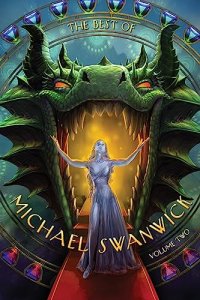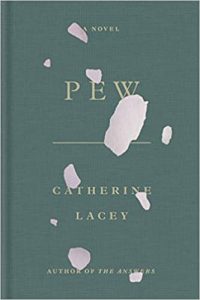Paul Di Filippo Reviews The Best of Michael Swanwick, Volume Two
 The Best of Michael Swanwick, Volume Two, MIchael Swanwick (Subterranean Press 978-1-64524-112-6, hardcover, 536pp, $50) July 2023
The Best of Michael Swanwick, Volume Two, MIchael Swanwick (Subterranean Press 978-1-64524-112-6, hardcover, 536pp, $50) July 2023
Is it too soon to assess the career magnitude of those writers who debuted in the 1980s? That era, after all, close as it seems to some of us, is forty years gone, offering us long track records of publication to peruse and also a certain lofty vantage from the year 2023. Several generations of readers have arisen for whom the period is ancient history. And Time’s cruel scythe has even cut down many practitioners who arose back then, rendering conclusive judgments on their halted careers more feasible—Lucius Shepard being perhaps the prime example.
But, incredibly, given the statistics and stresses for professional writers, many of that clade are still operating at the top of their game, thus perhaps allowing us momentarily to forget that they are, to a certain extent, also historical personages by now. Walter Jon Williams, Bruce Sterling, William Gibson, James Patrick Kelly, Pat Cadigan, John Kessel, John Shirley, Kris Rusch—the honor roll goes on and on.
Inscribed in gold amongst those names is that of Michael Swanwick. Having produced a raft of great and award-winning novels—the most recent being The Iron Dragon’s Mother in 2019—his stature in the field seems assured. But it’s perhaps for his gleeful, assured, endlessly variegated short fiction that he might yet be best recalled. And while only posterity can say for sure, we, his contemporaries, can revel in the wealth of tales without needing to judge.
This latest collection affirms Swanwick’s love for the short story genre—a passion addressed in his touching introduction, “The Apple Tree, the Vacuum Tubes, and All the World Besides”—and the book demonstrates his admirable range and proficiency.
Due to its generous bounty, I cannot address every single entry in this limited space, so let’s hit some choice samples. But first, an observation.
These stories embody a paradox. They are indisputably modern and even postmodern, definitely of the twenty-first century. And yet they can almost be read as core SF from decades past. In other words, had you as a contemporary reader encountered one of these Swanwick stories in the pages of Unknown or Astounding or Galaxy, you probably would not have been taken very much aback, but simply regarded the tale as a high-quality instance of what those zines were already publishing. (Except insofar as Swanwick’s sexual frankness obtrudes; a story like “The Bordello in Faerie” would have certainly freaked out readers in, oh, 1953.) This timeless quality stems from Swanwick’s deep knowledge of the field and his reverence for it. (See his monograph on James Branch Cabell, and other studies.). I think he must regard his work as extension of an honorable lineage, just as much as it is a product of these times.
We open with “The Mongolian Wizard”, a kind of counterfactual steampunk tale, which has a companion in “The New Prometheus”. Swanwick resonates here with something like Ian MacLeod’s The Light Ages.
“Starlight Express” has a bit of Dying Earth magic about it, as we and the hero encounter a mysterious woman plucked from a past era by high tech. “Tin Marsh”, with its psychological thriller/revenge aspects set amidst the vivid and exotic pitfalls of Venus might have been conjured up by Hal Clement, and happily published by John W. Campbell. And yet its moral complexity is something found generally only in the present.
Recall Sheckley’s story of the AI city as Jewish mother (“Street of Dreams, Feet of Clay”), and you might have tumbled upon Swanwick’s inspiration for “Steadfast Castle”, in which a man’s jealous domicile proves deadly.
“Of Finest Scarlet Was Her Gown” is my absolute favorite of the whole book. It chronicles the exploits in literal Hell of loyal daughter Su-yin who seeks to undo her father’s damnation. The entire cast is memorable, there’s much humor as well as pathos, and the climax has lots of kick. It’s a tale that Tim Powers would be proud to claim. Here’s how it launches, with an unusual portrait of the Devil:
Su-yin was fifteen when her father was taken away. She awoke from uneasy sleep that night to the sound of tires on the gravel drive and a wash of headlights through her room. From the window she saw a stretch limousine glide to a halt in front of the house. Two broad-shouldered men wearing sunglasses got out to either side. One opened the passenger door. A woman emerged. She wore a dress that covered everything from her neck to her ankles except for a long slit on the side that went all the way up one leg.
This passage gives me a chance to comment upon Swanwick’s style and narrative method. Highly visual, with lots of fine dialogue, his narratives never wallow in obscurity. While his novums might be bizarre and far-out, he presents them with utmost clarity, helping the reader into each scenario before rocketing off.
“The Dala Horse” offers a magical-realist odyssey of a young girl named Linnea, whose sentient toy horse functions as her companion and protector. To jump from this to the cyberpunk excursion that is “Libertarian Russia” is both salutarily mind-blowing and an example of Swanwick’s range and facility.
“Annie Without Crow” is probably my second favorite tale, possessing a comedic, Zelaznyesque bent. Our demiurgic Annie takes a jaunt back to Elizabethan England and gleefully wreaks havoc among the mortals. And again, a pleasantly disorienting disjunction occurs, as it is followed by the grim “Passage of Earth,” involving aliens and levels of reality in a way that Michael Shea would certainly have endorsed.
“The Woman Who Shook the World Tree” gives us an authentic portrait of scientific genius—both its miseries and triumphs. A wonderful fairytale ambiance cloaks “Goblin Lake”.
Down, down, down, Jack sank, choking. The water was as clear as crystal and yet far down in the distance as black as coal, for the monstrousness of its depth. So filled with anger at his comrades was he that at first he did not notice when he stopped choking. Then, before he could properly marvel at this strange turn of circumstance, he was suddenly distracted by movements in the depths of the lake. At a distance, the creatures looked like so many frogs, flitting to and fro, but as they grew closer they seemed very much like human beings, save that their skin was green and their clothes, though fine and flowing, were clearly woven of seaweeds and other underwater plants.
More and more of these water-spirits rose up like diving birds and quickly surrounded Jack. So great was their number that he had no choice but to go with them when, by gestures and frowns, the sylphs indicated he was to descend to the very bottom of the Mummelsee.
And for a glorious finale we get a Thorne-Smith-style romp with “Universe Box,” in which our hero Howard receives a visit from an Uncle he never knew he had, this relative bearing the titular box that contains—what else?—the entirety of creation.
This magnificent collection should hold Swanwick’s fans until he has assembled enough winners for a third volume. Given his passionate prolificity, we should not have to wait too long!
 While you are here, please take a moment to support Locus with a one-time or recurring donation. We rely on reader donations to keep the magazine and site going, and would like to keep the site paywall free, but WE NEED YOUR FINANCIAL SUPPORT to continue quality coverage of the science fiction and fantasy field.
While you are here, please take a moment to support Locus with a one-time or recurring donation. We rely on reader donations to keep the magazine and site going, and would like to keep the site paywall free, but WE NEED YOUR FINANCIAL SUPPORT to continue quality coverage of the science fiction and fantasy field.
©Locus Magazine. Copyrighted material may not be republished without permission of LSFF.







